
Menticirrhus is a genus of marine ray-finned fish belonng to the family Sciaenidae, the drums or croakers. They are commonly known as kingcroakers or kingfish. These fish are found in the Western Atlantic and Eastern Pacific Oceans.

Pogonias is a genus of ray-finned fish in the family Sciaenidae. It was formerly believed to be a monotypic genus only containing the black drum, but a second species was re-described in 2019.
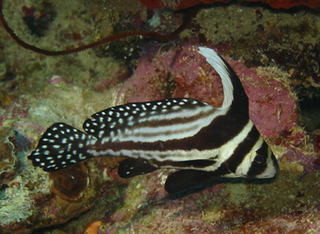
The spotted drum or spotted ribbonfish, is a species of marine ray-finned fish belonging to the family Sciaenidae, the drums and croakers. This species is found in the western Atlantic Ocean.

Cilus, is a monospecific genus of marine ray-finned fish belonging to the family Sciaenidae, the croakers and drums. Its only species is Cilus gilberti, the corvina or corvina drum, which is found mostly tropical to temperate coastal waters of the southeastern Pacific along Central and South America. The corvina is highly prized in South America as a food fish.
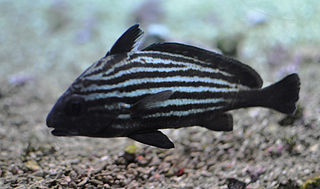
Pareques acuminatus, commonly known as the high-hat, donkeyfish, cubbyu, Steindachner's ribbonfish, streaked ribbonfish, striped ribbonfish or striped drum, is a species of marine ray-finned fish belonging to the genus Pareques in the family Sciaenidae, the drums and croakers. This species is found in the western Atlantic Ocean.

Sciaena is a genus of marine ray-finned fishes belonging to the family Sciaenidae, the drums and croakers. These fishes are found in the Eastern Pacific Ocean and the Eastern Atlantic Ocean.

Nebris is a small genus of marine ray-finned fishes belonging to the family Sciaenidae, the drums and croakers. There are two species in the genus, one in the Western Atlantic Ocean and one in the Eastern Pacific Ocean.
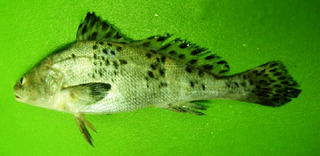
The blackspotted croaker, also known in Australia as the black jewfish, is a species of marine ray-finned fish belonging to the family Sciaenidae, the drums and croakers. This fish is found in the Indo-Pacific region. It is the only species in the monospecific genus Protonibea.
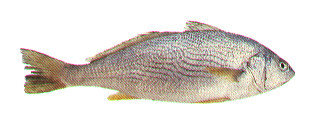
Umbrina is a genus of fish from the croaker family Sciaenidae. The genus contains 17 species occurring in tropical and warm temperate waters of the Atlantic, the Mediterranean, the Western Indian Ocean and the eastern Pacific.

Pareques is a genus of marine ray-finned fishes belonging to the family Sciaenidae, the drums and croakers. These fishes are found in the western Atlantic Ocean and eastern Pacific Ocean.

Lonchurus is a genus of marine ray-finned fishes belonging to the family Sciaenidae, the drums and croakers. These fishes are found in the Western Atlantic.

Eques is a small genus of marine ray-finned fishes belonging to the family Sciaenidae, the drums and croakers. These fishes are found in the Western Atlantic Ocean.

Isopisthus is a genus of marine ray-finned fishes belonging to the family Sciaenidae, the drums and croakers. These fishes are found in the western Atlantic and eastern Pacific Oceans.

Johnius carutta, the karut croaker or purple jewfish, is a species of marine ray-finned fish belonging to the family Sciaenidae, the drums and croakers. This species is found in the western Indian Ocean.
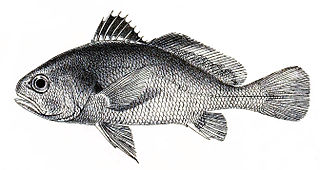
The kathala croaker is a species of marine ray-finned fish belonging to the family Sciaenidae, the drums and croakers. This species is found in the Indian Ocean off South Asia. It is the only species in the monospecific genus Kathala.

Macrodon is a genus of marine ray-finned fishes belonging to the family Sciaenidae, the drums and croakers. These fishes are found in the eastern Pacific and western Atlantic Oceans.
Paralonchurus is a genus of marine ray-finned fishes belonging to the family Sciaenidae, the drums and croakers. These fishes are found in the eastern Pacific Ocean with one species in the western Atlantic Ocean.

The half-mourning croaker is a species of marine ray-finned fish belonging to the family Sciaenidae, the drums and croakers. It is the only species in the monospecific genus Paranibea. This fish is found in the Indo-Pacific region.
Protosciaena is a small genus of marine ray-finned fishes belonging to the family Sciaenidae, the drums and croakers. These fishes are found in the Western Atlantic Ocean.

The boe drum is a species of marine ray-finned fish belonging to the family Sciaenidae, the drums and croakers. It is the only species in the monospecific genus Pteroscion. The boe drum is found in the eastern Atlantic Ocean off western coast of Africa.



















